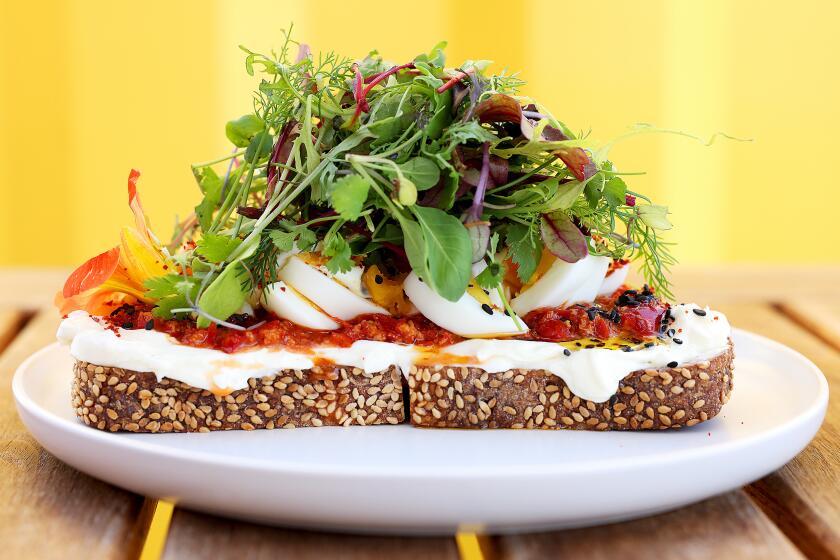Market Watch: The renaissance of the Italian lemon
Lemons are most in demand in summer, for making lemonade, serving with cocktails and squeezing on fish. There’s a little bit of a disconnect with production, which is concentrated, from different growing areas, in the fall to spring months; but there’s still plenty of supply throughout the summer from coastal districts. Most commercial production is of the standard Eureka and Lisbon varieties, but in the last decade a few farmers market and specialty growers have planted Italian varieties, famed for their romantic history and intensely aromatic rinds.
Most of the lemons used in the United States until the 1890s were imported from Italy, and before then it was controversial whether California would ever develop the varieties and expertise that would allow it to supply the domestic market. Planting the Eureka and Lisbon lemons, local growers eventually succeeded in a big way, so that today about 60,000 acres are grown in California and Arizona, and imports of fresh Italian lemons are rare.
Italian lemons still have a mystique, however, dating to the Roman era, when they were depicted on Pompeian frescoes. They have been celebrated by writers such as Tasso, Goethe and Eugenio Montale, and are renowned for their intense aroma, which is responsible for the distinctive flavor of limoncello, the lemon liqueur.
The primary lemon-growing areas in Italy are Sicily, particularly the eastern coast around Messina and Syracuse, and the Sorrento and Amalfi coasts, near Naples. The Femminello group of varieties, named for their protruding nipples and ample form, account for the majority of production. There are half a dozen selections that have their own particular characteristics but share a similar aromatic profile, although there are subtle differences in fragrance and flavor.
For reasons that remain unclear, Femminello lemon trees were not imported or did not become established in the early days of California citriculture. Two varieties, the original Femminello Ovale and a disease-resistant selection called Femminello Santa Teresa, were brought in about 50 years ago but did not become widely available to farmers. Only in the last decade did four or five growers put in small plantings of Italian lemons after encountering them on tours of the variety collection at the Willits & Newcomb nursery in Arvin.
One of those was Lance Walheim of California Citrus Specialties, who with his partner, Mike Foskett, planted several hundred trees of Italian lemons. He became so intrigued that he visited the Sorrento lemon district, where he found that it was hard to unravel the influence of the varieties, climate, ripeness and growing practices on fruit quality.
“On the Sorrento coast they say the climate and rich, deep volcanic soil contribute to the flavor of the lemons,” he said. “Also, the aromatic oils are strongest when the lemons are turning from green to yellow, and that’s when they make limoncello.”
Steve Smith of Mud Creek Ranch, who is so passionate about unusual crops that his organic farm in Santa Paula is a virtual one-family agricultural experiment station, planted about 100 trees of Italian lemons. His wife, Robin, just started bringing the most recent picking to the Hollywood and Beverly Hills markets on Sundays, and Santa Monica on Wednesdays, where they’re popular with chefs, she says.
William and Linda Zaiser of Rancho del Sol planted 168 trees, about 2 acres, of Femminello Santa Teresa in Jamul, 15 miles east of San Diego.
“They’re beautiful, vigorous trees, the fruits have very few seeds and their aromatics are absolutely different from normal lemons,” says Bill Zaiser.
Their Femminellos, available year-round, are sold by variety at Jimbo’s markets in San Diego County and by mail order, $30 for 10 pounds, including shipping. Linda Zaiser will be offering limoncello classes and a tasting party at the farm ($40, call [619] 669-1145 for an appointment); she also will do a demonstration at the Little Italy farmers market in San Diego on Saturday, June 18.
We may very well be seeing more Femminello lemons in the years to come, since scientists at the University of California and University of Arizona have found that the Santa Teresa selection is among the more productive lemon varieties in a test planting in the Coachella desert.
Dry-farmed Blenheim apricots
Many of us dream all year of the brief season for Blenheim apricots, whose sweetness, intense musky aroma and moist, jam-like texture amount to all that an apricot can be. This year the crop has been delayed by cool spring weather, but in the last week Helle and Eric Todd of Forcefield Farm, from Santa Paula, started bringing dry-farmed Blenheims with fantastically rich, concentrated flavor to the Hollywood, Beverly Hills and Santa Monica markets.
Apricot aficionados particularly prize dry-farmed fruits, which are smaller but more intense in flavor than crops from irrigated orchards. There’s something about the stony, reflective soil at the Todds’ farm that takes this process to the ultimate, imparting a minerally tang and firm but melting texture to the fruits. The most beautiful and delicious specimens have a reddish speckling that indicates that they have enjoyed a sun-exposed position on the tree. Some fruits may display cosmetic imperfections, such as sunburn, “cat scratches” and bird pecks, but if there is a more exquisite apricot available in these parts, I know it not.
More to Read
Eat your way across L.A.
Get our weekly Tasting Notes newsletter for reviews, news and more.
You may occasionally receive promotional content from the Los Angeles Times.









